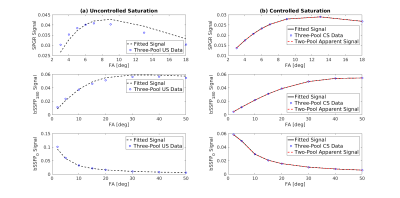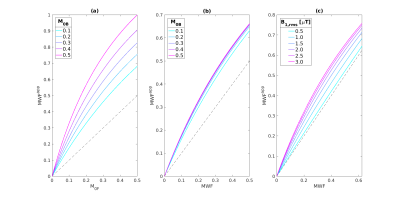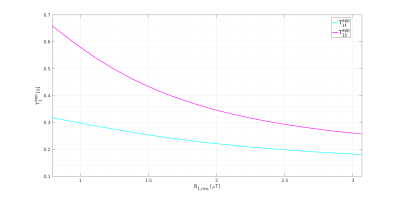5651
Controlling magnetisation transfer and exchange effects in mcDESPOT relaxometry.1Biomedical Engineering and Imaging Sciences, King's College London, London, United Kingdom
Synopsis
Magnetisation transfer (MT) has been found to contribute to parameter estimation bias in sequences used in the two-pool relaxometry technique, mcDESPOT. Recent work shows that using controlled saturation magnetisation transfer (CSMT) RF-pulses, a two-pool system (free- and bound-pools) can behave as a single pool with modified equilibrium magnetisation and longitudinal relaxation rate. Here, we investigate the use of CSMT to model MT-effects in a three-pool system (exchange + MT) and show that under these conditions, signal behaves as a two-pool system and matches a mcDESPOT model but characterised by different parameters than those originally assumed.
Introduction
Multicomponent DESPOT (mcDESPOT) models tissue response using a system of two or more exchanging ‘free’ (i.e. MR-visible) magnetisation components.1 In its two-pool form, mcDESPOT has been used for characterisation of white matter (WM), with the two components usually identified as intra/extracellular water (slow-relaxing) and myelin-water (fast-relaxing). The myelin water fraction (MWF) calculated from these estimates has been shown to consistently overestimate the value derived from multiecho CPMG methods.2,3 WM is known to yield a strong magnetisation transfer (MT) effect that is not ordinarily modelled in mcDESPOT; other work has suggested this to be a source for MWF overestimation.4,5
The MT-effect may be modelled by the addition of a ‘bound’ (i.e. macromolecular) pool of magnetisation.5,6 RF-pulses rotate ‘free’ magnetisation, but saturate ‘bound’ magnetisation according to applied RF-power $$$W$$$ (Equation 1), where $$$B_{1,rms}$$$ is RMS pulse amplitude over the whole sequence and $$$G$$$ is bound-pool absorption factor.
$$ W=\pi G(\Delta)\gamma^2B_{1,rms}^2 $$
The recently proposed controlled saturation magnetisation transfer (CSMT) approach has been shown to allow a simple two-pool MT-system (i.e. one free-pool, one bound-pool) to behave as a single free-pool during DESPOT-style relaxometry by keeping $$$W$$$ constant over all acquisitions, irrespective of the applied flip angle (FA).7
In this work, we aim to extend this approach to consider a system with two free components, of the type typically modelled in mcDESPOT. We consider how a ‘ground-truth’ scenario with three pools (i.e. two free-pools and one bound-pool) will produce parameter estimation bias when fitted using a two-pool model that does not include any bound component (hereafter referred to as the ‘mcDESPOT’ model).
Methods
Figure 1 illustrates our three-pool configuration, including a bound-pool to account for MT-effects.5 We use the Bloch-McConnell equations to model the evolution of magnetisation for such a system and calculate steady-state solutions independently for SPGR and bSSFP. We then fit a mcDESPOT model to three-pool (ground-truth) signals, simulated using either controlled (i.e. same $$$W$$$ regardless of FA) or uncontrolled saturation methods. Least-square criteria, using fmincon in Matlab2016b, were applied.
Comparison of the differential equations governing mcDESPOT and three-pool models suggests that the latter can be fitted using a mcDESPOT model, with 'apparent' parameters shown in Figure 2. Note that the assumption made in this derivation is that the bound-pool is in a steady-state.
Results and Discussion
When saturation is uncontrolled, a mcDESPOT model fits poorly (NRMSE = 6.4%) to simulated three-pool data, particularly for SPGR (Figure 3a). This results in inaccurate parameter estimation due to the dependence of each apparent parameter on RF-power. In contrast, the same model fits very well (NRMSE = 0.03%) for simulated controlled saturation data (Figure 3b). The signal predicted using the mcDESPOT model with the apparent parameter values in Figure 2 also fits very well (NRMSE = 0.25%), although not perfectly because the bound-pool steady-state assumption is an approximation. Using CSMT, a three-pool system behaves as a two-pool model, characterised by the parameters in Figure 2; model dimensionality is reduced without explicit modelling of a bound-pool, as has been performed previously.5
Figure 2 indicates that given no direct exchange between MR-visible pools, an apparent exchange ($$$\Delta k_{FS}$$$) remains that is solely mediated by the bound-pool; these additional exchange pathways are highlighted in Figure 1. This implies that the exchange rates observed using mcDESPOT could reflect exchange mediated purely by MT. $$$\Delta k_{FS}$$$ increases almost linearly with $$$k_{B} $$$ but decreases for larger $$$B_{1,rms}$$$, as magnetisation entering the bound-pool is lost through saturation.
Figures 4 and 5 use the derived parameter expressions to investigate how mcDESPOT fitting would be influenced by the presence of a bound-pool, assuming $$$k_{FS}$$$ = 0 and $$$k_{B}$$$ = $$$k_{BF}$$$ = $$$k_{BS}$$$. Figure 4 suggests that the apparent MWF (in Figure 2) is not the same as the true MWF, defined as $$$\frac{M_{0F}}{M_{0F}+M_{0S}}$$$, but the relationship is monotonic and relatively insensitive to changes in bound-pool fraction. It also consistently overestimates MWF, as others have observed. However, Figure 4c shows that MWFapp is strongly influenced by RF-power level, with lower $$$W$$$ leading to a closer relationship to the ground-truth.
Figure 5 demonstrates that higher $$$B_{1,rms}$$$ leads to reduced apparent longitudinal relaxation times, as has been reported before.7 This has clear implications for the use of $$$T_{1}$$$ as a quantitative tissue parameter.
Conclusions
In conclusion, a three-pool system can be modelled using two-pools and derived apparent parameter expressions in Figure 2. MT-effects can lead to bias in estimated parameter values and CSMT is needed to obtain a good fit.Acknowledgements
This work is funded by the King’s College London & Imperial College London EPSRC Centre for Doctoral Training in Medical Imaging [EP/L015226/1]. This work was supported by the Wellcome EPSRC Centre for Medical Engineering at King’s College London [WT 203148/Z/16/Z], MRC Strategic Grant [MR/K006355/1] and by the National Institute for Health Research (NIHR) Biomedical Research Centre based at Guy’s and St Thomas’ NHS Foundation Trust and King’s College London. The views expressed are those of the authors and not necessarily those of the NHS, the NIHR or the Department of Health.References
1. Deoni, S. C. L., Rutt, B. K., Arun, T., Pierpaoli, C. & Jones, D. K. Gleaning multicomponent T1 and T2 information from steady-state imaging data. Magn. Reson. Med. 2008;60:1372–1387.
2. MacKay, A. L. et al. In vivo visualization of myelin water in brain by magnetic resonance. Magn. Reson. Med. 1994;31:673–677.
3. Alonso-Ortiz, E., Levesque, I. R. & Pike, G. B. MRI-based myelin water imaging: a technical review. Magn. Reson. Med. 2015;73:70–81.
4. Zhang, J., Kolind, S. H., Laule, C. & MacKay, A. L. How does magnetization transfer influence mcDESPOT results? Magn. Reson. Med. 2015;74:1327–1335.
5. Liu, F., Block, W. F., Kijowski, R. & Samsonov, A. A. Rapid multicomponent relaxometry in steady state with correction of magnetization transfer effects. Magn. Reson. Med. 2016;75:1423–1433.
6. Henkelman, R. M., Stanisz, G. J. & Graham, S. J. Magnetization transfer in MRI: a review. NMR Biomed. 2001;14:57–64.
7. Teixeira, R. P. A. G., Price, A. N., Baburamani, A. A., Malik, S. J. & Hajnal, J. V. Robust VFA relaxometry by Continuous Saturation of Magnetization Transfer (CSMT) effects with non-selective multi-band pulses. In: ISMRM 25th Annual Meeting & Exhibition 2017.
Figures


